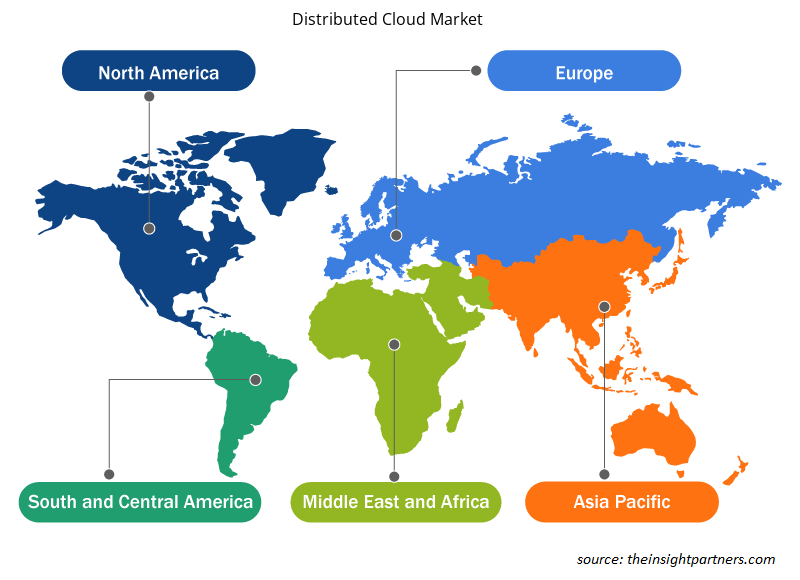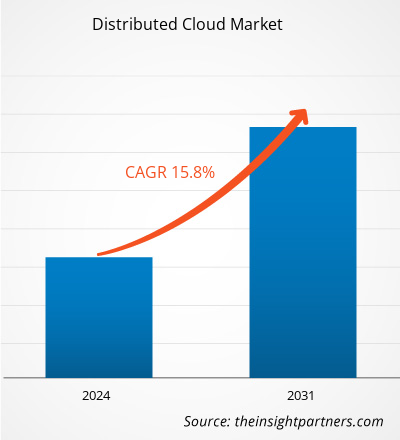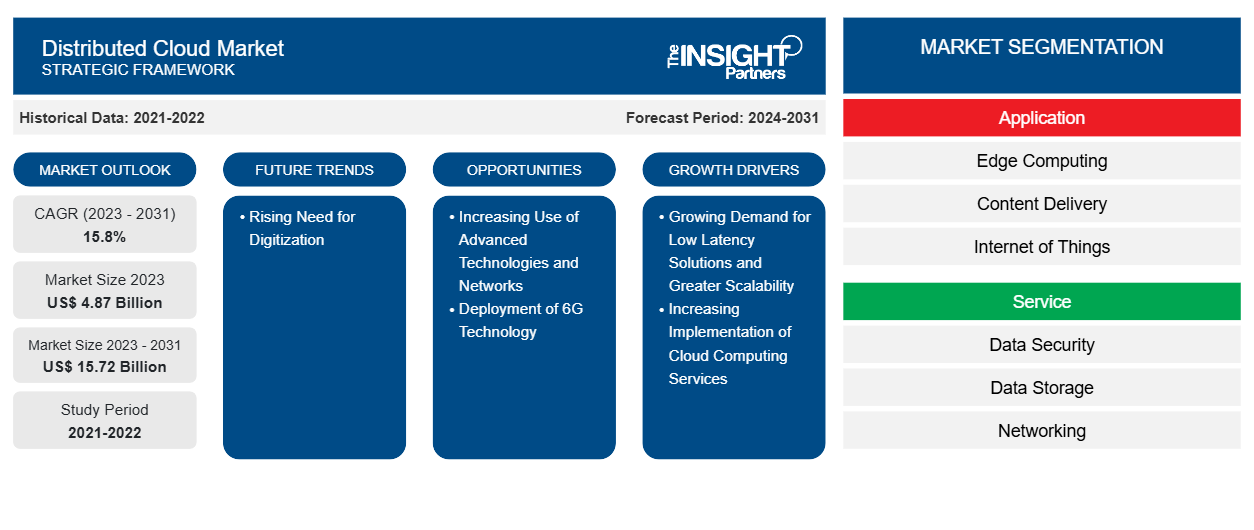Se prevé que el tamaño del mercado de la nube distribuida alcance los 15.720 millones de dólares en 2031, frente a los 4.870 millones de dólares en 2023. Se espera que el mercado registre una CAGR del 15,8 % durante el período 2023-2031. Es probable que la creciente necesidad de digitalización traiga consigo nuevas tendencias en el mercado.
Análisis del mercado de la nube distribuida
El crecimiento del mercado de la nube distribuida se atribuye a la creciente demanda de soluciones de baja latencia y mayor escalabilidad. La computación en la nube distribuida también aumenta la capacidad de respuesta de los servicios al reubicar las tareas de procesamiento más cerca del usuario final. Además, la creciente implementación de servicios de computación en la nube en varias industrias, como la automotriz, la educación, las finanzas, el comercio minorista, el sector inmobiliario, la agricultura, los medios de comunicación y el entretenimiento, impulsa el mercado. Además, se prevé que la creciente demanda de digitalización y la implementación de la tecnología 6G impulse el mercado de la nube distribuida en los próximos años. En Asia Pacífico, hay un aumento notable en el crecimiento y la inversión en computación en la nube, con un crecimiento esperado en los ingresos por servicios de nube pública. China es reconocida como el mercado de nube pública más grande de la región. Las principales empresas de infraestructura como servicio (IaaS) como Alibaba Cloud y Huawei tienen su sede en China. Además, los gobiernos de Asia Pacífico están mostrando cada vez más interés en soluciones de nube soberana debido a las disrupciones geopolíticas, el aumento de las amenazas cibernéticas, los cambios en las leyes de protección de datos y los cambios en las políticas comerciales digitales.
Descripción general del mercado de la nube distribuida
La arquitectura de una nube distribuida implica múltiples nubes que ayudan a cumplir con los requisitos de cumplimiento y las necesidades de rendimiento, así como a respaldar la computación de borde mientras está administrada de manera central por un proveedor de nube pública. El crecimiento de la Internet de las cosas (IoT) y la computación de borde han sido un impulsor importante para las implementaciones de nube distribuida. Las aplicaciones de inteligencia artificial (IA) que mueven grandes cantidades de datos desde ubicaciones de borde a la nube requieren que los servicios de nube estén lo más cerca posible de las ubicaciones de borde; además, mover los recursos de la nube a la ubicación de borde en sí puede aumentar significativamente el rendimiento de estas aplicaciones.
Personalice este informe según sus necesidades
Obtendrá personalización en cualquier informe, sin cargo, incluidas partes de este informe o análisis a nivel de país, paquete de datos de Excel, así como también grandes ofertas y descuentos para empresas emergentes y universidades.
-
Obtenga las principales tendencias clave del mercado de este informe.Esta muestra GRATUITA incluirá análisis de datos, desde tendencias del mercado hasta estimaciones y pronósticos.
Factores impulsores y oportunidades del mercado de la nube distribuida
Creciente demanda de soluciones de baja latencia y mayor escalabilidad para favorecer al mercado
La baja latencia es una red informática que se ha mejorado para procesar un gran volumen de mensajes de datos con el menor tiempo de retraso. Estas redes están destinadas a respaldar funciones que requieren acceso casi en tiempo real a datos que cambian rápidamente. La computación en la nube distribuida reduce la latencia y aumenta la capacidad de respuesta de los servicios al reubicar las tareas de procesamiento más cerca del usuario final. Luego, los datos se administran localmente en lugar de en un servidor centralizado, lo que desarrolla una experiencia de usuario superior. Además, varias empresas ofrecieron ofertas de nube distribuida para satisfacer las necesidades de baja latencia. Por ejemplo, en septiembre de 2023, Oracle amplió sus ofertas de nube distribuida para satisfacer las diversas necesidades de las organizaciones y la creciente demanda global de servicios de Oracle Cloud Infrastructure (OCI). Oracle Database Azure y MySQL HeatWave Lakehouse en AWS son las nuevas incorporaciones a la nube distribuida de OCI. Como resultado, las empresas obtienen una mayor flexibilidad para implementar servicios en la nube en cualquier lugar al tiempo que abordan numerosos requisitos de privacidad de datos, soberanía de datos y baja latencia, lo que permite el acceso a más de 100 servicios diseñados para ejecutar cualquier carga de trabajo.
Despliegue de la tecnología 6G
Se acepta que 6G ofrece una latencia en el rango de microsegundos. Esto permite que los servicios de nube distribuidos realicen tareas de procesamiento en tiempo real, como realidad aumentada (RA), realidad virtual (RV) y conducción autónoma, con una eficiencia sin precedentes. Varias empresas ofrecen sistemas de comunicaciones y nube distribuida 6G. Por ejemplo, Next G Alliance (NGA) ofrece un sistema de comunicaciones y nube distribuida. NGA desarrolló este sistema para la visión 6G de América del Norte. Pretende hacer de los sistemas 6G una nube de área amplia con abundante computación y distribución de carga de trabajo entre dispositivos, centros de datos y nodos de red. El sistema de comunicaciones y nube distribuida 6G es un paso hacia capacidades de sistema de computación y comunicación unificadas que no se han logrado en 4G y 5G en la nubeificación de la red y la computación de borde. Por lo tanto, se anticipa que la implementación de la tecnología 6G brindará varias oportunidades para el crecimiento del mercado de la nube distribuida durante el período de pronóstico.
Análisis de segmentación del informe del mercado de la nube distribuida
Los segmentos clave que contribuyeron a la derivación del análisis del mercado de nube distribuida son la aplicación, el servicio, la empresa, el tamaño y la vertical de la industria.
- Según la aplicación, el mercado de la nube distribuida se divide en computación de borde, distribución de contenido, Internet de las cosas y otros. El segmento de computación de borde tuvo la mayor participación de mercado en 2023. La computación de borde es un esquema de computación distribuida que acerca las aplicaciones empresariales a las fuentes de datos, como servidores de borde locales o dispositivos IoT. Esto da como resultado tiempos de respuesta mejorados, información más rápida y mejor disponibilidad de ancho de banda.
- Por servicio, el mercado se segmenta en seguridad de datos, almacenamiento de datos, redes y otros. El segmento de almacenamiento de datos tuvo la mayor participación del mercado en 2023. Los servicios de almacenamiento de datos implican la implementación de medidas para almacenar y administrar datos de forma segura en diversos entornos de nube. Esto incluye abordar inquietudes como garantizar la disponibilidad de los datos, la pérdida de control sobre los datos y la necesidad de contar con estrategias sólidas de respaldo y recuperación de datos.
- En términos de tamaño de empresa, el mercado se divide en grandes empresas y pymes. El segmento de grandes empresas tenía una participación significativa del mercado en 2023. Las grandes corporaciones utilizan el modelo de computación distribuida para distribuir de manera eficaz varias etapas de sus procesos comerciales a través de una red informática, generalmente estructurada en capas de presentación, aplicación y datos. Las grandes empresas están adoptando cada vez más estrategias multicloud, distribuyendo sus necesidades informáticas entre múltiples proveedores de la nube para evitar quedar atados a un solo proveedor y reforzar su resiliencia.SMEs. The large enterprises segment held a significant share of the market in 2023. Major corporations utilize the distributed computing model to effectively distribute various stages of their business processes across a computer network, typically structured into presentation, application, and data layers. Large enterprises are increasingly adopting multi-cloud strategies, distributing their computing needs across multiple cloud providers to avoid being locked into a single vendor and bolster their resilience.
- Según el sector vertical, el mercado de la nube distribuida se divide en BFSI, atención médica, comercio minorista y comercio electrónico, fabricación, TI y telecomunicaciones, energía y servicios públicos, medios y entretenimiento, gobierno y defensa, entre otros. La industria BFSI está aprovechando cada vez más el potencial de la tecnología de nube distribuida para abordar desafíos cruciales y fomentar la innovación. Esta industria enfrenta constantemente la amenaza inminente de los ciberataques, el requisito de optimizar la recopilación de datos de los clientes al tiempo que se mantiene la integridad de los datos y el requisito apremiante de cumplir con estándares y regulaciones de seguridad estrictos.BFSI, healthcare, retail & e-commerce, manufacturing, IT & telecom, energy & utilities, media & entertainment, government & defense, and others. The BFSI industry is increasingly capitalizing on the potential of distributed cloud technology to tackle crucial challenges and foster innovation. This industry consistently confronts the forthcoming threat of cyberattacks, the requirement to streamline customer data collection while upholding data integrity, and the pressing requirement to adhere to stringent security standards and regulations.
Análisis de la cuota de mercado de la nube distribuida por geografía
El alcance geográfico del informe del mercado de nube distribuida se divide principalmente en cinco regiones: América del Norte, Asia Pacífico, Europa, Medio Oriente y África, y América del Sur y Central.
En América del Norte, se prevé un crecimiento significativo en el mercado de la nube distribuida debido al aumento de las actividades de habilitación de la nube y las tendencias dentro del mercado de la nube. La nube distribuida permite a las empresas transferir datos de cualquier tamaño sin cargos adicionales y puede garantizar la soberanía de los datos al tiempo que cumple con el Reglamento General de Protección de Datos (GDPR). Proporciona un lago de datos impulsado por IA que centraliza los datos para mejorar la calidad del análisis predictivo. Se puede utilizar en diferentes escenarios, como fabricación, IoT, aprendizaje automático y creación de imágenes.
El sector de computación en la nube distribuida de Europa se define por una combinación variada de tecnologías y normativas. Las tecnologías en la nube se están expandiendo, lo que da lugar a una adopción variada de tecnologías en la nube en los países de la UE. La UE está realizando esfuerzos notables para permitir la transición al borde y crear servicios en la nube y en el borde compatibles para respaldar el establecimiento de espacios de datos europeos unificados. Además, se hace hincapié en garantizar la residencia de los datos, controlar la dotación de personal operativo y minimizar los efectos de los desafíos jurisdiccionales, especialmente en sectores regulados, por medios como el Sistema Europeo de Certificación de la Ciberseguridad (EUCS) para los servicios en la nube.
Perspectivas regionales del mercado de la nube distribuida
Los analistas de Insight Partners explicaron en detalle las tendencias y los factores regionales que influyen en el mercado de la nube distribuida durante el período de pronóstico. Esta sección también analiza los segmentos y la geografía del mercado de la nube distribuida en América del Norte, Europa, Asia Pacífico, Oriente Medio y África, y América del Sur y Central.

- Obtenga datos regionales específicos para el mercado de nube distribuida
Alcance del informe sobre el mercado de la nube distribuida
| Atributo del informe | Detalles |
|---|---|
| Tamaño del mercado en 2023 | US$ 4.87 mil millones |
| Tamaño del mercado en 2031 | US$ 15,72 mil millones |
| CAGR global (2023 - 2031) | 15,8% |
| Datos históricos | 2021-2022 |
| Período de pronóstico | 2024-2031 |
| Segmentos cubiertos |
Por aplicación
|
| Regiones y países cubiertos |
América del norte
|
| Líderes del mercado y perfiles de empresas clave |
|
Densidad de actores del mercado de la nube distribuida: comprensión de su impacto en la dinámica empresarial
El mercado de la nube distribuida está creciendo rápidamente, impulsado por la creciente demanda de los usuarios finales debido a factores como la evolución de las preferencias de los consumidores, los avances tecnológicos y una mayor conciencia de los beneficios del producto. A medida que aumenta la demanda, las empresas amplían sus ofertas, innovan para satisfacer las necesidades de los consumidores y aprovechan las tendencias emergentes, lo que impulsa aún más el crecimiento del mercado.
La densidad de actores del mercado se refiere a la distribución de las empresas o firmas que operan dentro de un mercado o industria en particular. Indica cuántos competidores (actores del mercado) están presentes en un espacio de mercado determinado en relación con su tamaño o valor total de mercado.
Las principales empresas que operan en el mercado de la nube distribuida son:
- Nube de Alibaba
- Servicios web de Amazon, Inc.
- IBM
- Oráculo
- Microsoft
Descargo de responsabilidad : Las empresas enumeradas anteriormente no están clasificadas en ningún orden particular.

- Obtenga una descripción general de los principales actores clave del mercado de la nube distribuida
Noticias y desarrollos recientes del mercado de la nube distribuida
El mercado de la nube distribuida se evalúa mediante la recopilación de datos cualitativos y cuantitativos a partir de una investigación primaria y secundaria, que incluye publicaciones corporativas importantes, datos de asociaciones y bases de datos. A continuación, se enumeran algunos de los avances en el mercado de la nube distribuida:
- Cloud Software Group Inc. y Microsoft Corp. anunciaron que están profundizando su colaboración a través de un acuerdo de asociación estratégica de ocho años. El acuerdo fortalecerá la colaboración de lanzamiento al mercado de la plataforma de escritorio y aplicación virtual Citrix® y respaldará el desarrollo de nuevas soluciones de inteligencia artificial y en la nube con una hoja de ruta de productos integrada. Además, Cloud Software Group asumirá un compromiso de $1.65 mil millones para la nube de Microsoft y sus capacidades de inteligencia artificial generativa.
(Fuente: Microsoft, sitio web de la empresa, abril de 2024)
- Oracle, Microsoft y OpenAl se han asociado para ampliar la plataforma de inteligencia artificial Microsoft Azure a Oracle Cloud Infrastructure (OCI) con el fin de brindar capacidad adicional a OpenAl. Las capacidades de inteligencia artificial especialmente diseñadas de OCI permiten a las empresas emergentes y a las grandes empresas crear y entrenar modelos de manera más rápida y confiable en cualquier lugar de la nube distribuida de Oracle.
(Fuente: Oracle, sitio web de la empresa, junio de 2024)
Informe sobre el mercado de la nube distribuida: cobertura y resultados
El informe “Tamaño y pronóstico del mercado de la nube distribuida (2021-2031)” proporciona un análisis detallado del mercado que cubre las siguientes áreas:
- Tamaño del mercado de la nube distribuida y pronóstico a nivel global, regional y nacional para todos los segmentos clave del mercado cubiertos bajo el alcance
- Tendencias del mercado de la nube distribuida, así como dinámicas del mercado, como impulsores, restricciones y oportunidades clave
- Análisis detallado de las cinco fuerzas de Porter y PEST y FODA
- Análisis del mercado de la nube distribuida que abarca las tendencias clave del mercado, el marco global y regional, los principales actores, las regulaciones y los desarrollos recientes del mercado
- Análisis del panorama de la industria y de la competencia que abarca la concentración del mercado, el análisis de mapas de calor, los actores destacados y los desarrollos recientes para el mercado de la nube distribuida
- Perfiles detallados de empresas
- Análisis histórico (2 años), año base, pronóstico (7 años) con CAGR
- Análisis PEST y FODA
- Tamaño del mercado, valor/volumen: global, regional y nacional
- Industria y panorama competitivo
- Conjunto de datos de Excel
Informes recientes
Testimonios
Razón para comprar
- Toma de decisiones informada
- Comprensión de la dinámica del mercado
- Análisis competitivo
- Información sobre clientes
- Pronósticos del mercado
- Mitigación de riesgos
- Planificación estratégica
- Justificación de la inversión
- Identificación de mercados emergentes
- Mejora de las estrategias de marketing
- Impulso de la eficiencia operativa
- Alineación con las tendencias regulatorias























 Obtenga una muestra gratuita para - Mercado de nube distribuida
Obtenga una muestra gratuita para - Mercado de nube distribuida